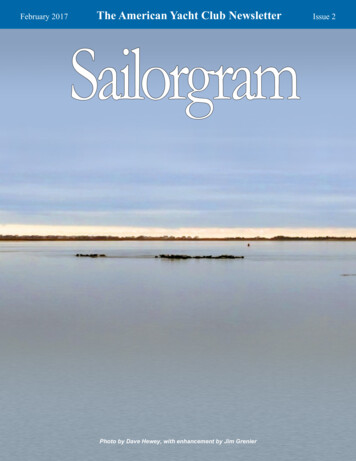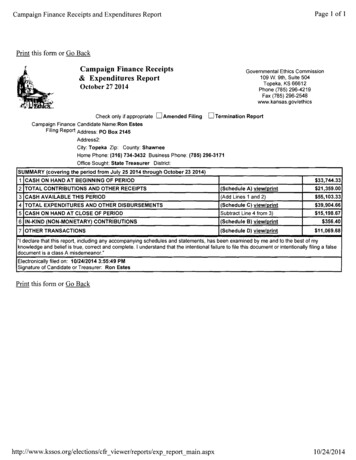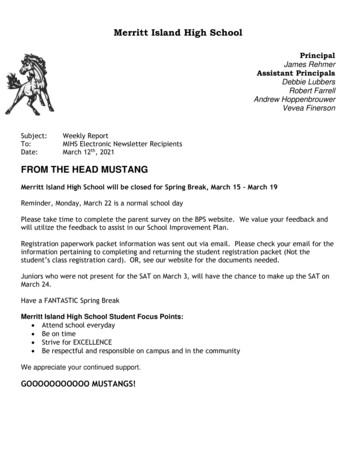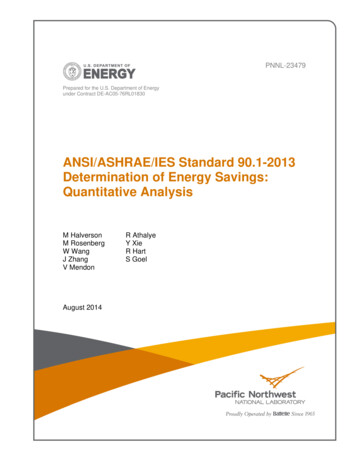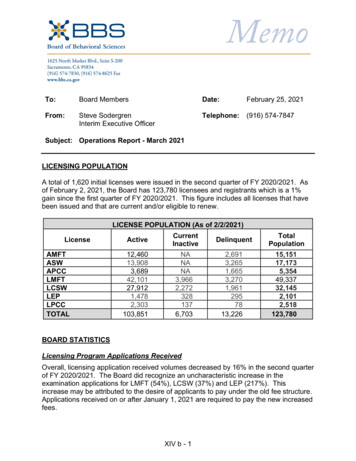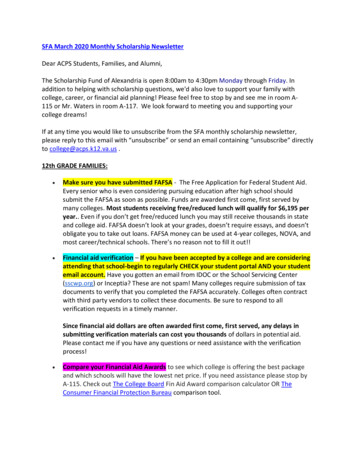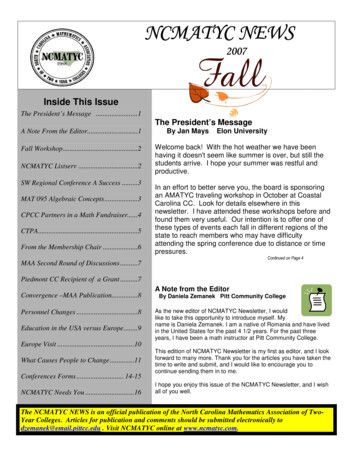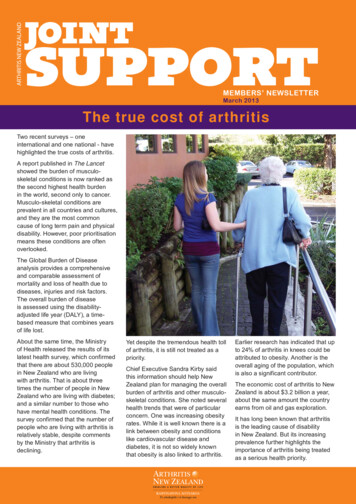
Transcription
MEMBERS’ NEWSLETTERMarch 2013The true cost of arthritisTwo recent surveys – oneinternational and one national - havehighlighted the true costs of arthritis.A report published in The Lancetshowed the burden of musculoskeletal conditions is now ranked asthe second highest health burdenin the world, second only to cancer.Musculo-skeletal conditions areprevalent in all countries and cultures,and they are the most commoncause of long term pain and physicaldisability. However, poor prioritisationmeans these conditions are oftenoverlooked.The Global Burden of Diseaseanalysis provides a comprehensiveand comparable assessment ofmortality and loss of health due todiseases, injuries and risk factors.The overall burden of diseaseis assessed using the disabilityadjusted life year (DALY), a timebased measure that combines yearsof life lost.About the same time, the Ministryof Health released the results of itslatest health survey, which confirmedthat there are about 530,000 peoplein New Zealand who are livingwith arthritis. That is about threetimes the number of people in NewZealand who are living with diabetes;and a similar number to those whohave mental health conditions. Thesurvey confirmed that the number ofpeople who are living with arthritis isrelatively stable, despite commentsby the Ministry that arthritis isdeclining.Yet despite the tremendous health tollof arthritis, it is still not treated as apriority.Chief Executive Sandra Kirby saidthis information should help NewZealand plan for managing the overallburden of arthritis and other musculoskeletal conditions. She noted severalhealth trends that were of particularconcern. One was increasing obesityrates. While it is well known there is alink between obesity and conditionslike cardiovascular disease anddiabetes, it is not so widely knownthat obesity is also linked to arthritis.Earlier research has indicated that upto 24% of arthritis in knees could beattributed to obesity. Another is theoverall aging of the population, whichis also a significant contributor.The economic cost of arthritis to NewZealand is about 3.2 billion a year,about the same amount the countryearns from oil and gas exploration.It has long been known that arthritisis the leading cause of disabilityin New Zealand. But its increasingprevalence further highlights theimportance of arthritis being treatedas a serious health priority.
From the PresidentA new year begins.In this issue:1The true cost of arthritis2From the President3From the Chief Executive4Home support explained;Kiwi Karma supportingarthritis5Team approach to treatingankylosing spondylitis6Telling her story; Children’sCamp 20137Advocacy programme8Corticosteroids andosteoporosis9Arthritis New Zealandphone service works!; LiveFacebook chat10The University of Otagoresearch theme: Smokingand rheumatoid arthritis; Yourold mobile phone can supportarthritis11Donate your desktop;Marathon effort12Global rheumatoid arthritiscampaign; Your pharmacist isso much bigger thanprescriptions13Fun photos support arthritis14Exercising with arthritis: whyexercise will help you combatjoint pain and stiffness15Arthritis and young adultsEditor: Darryl WardEmail: editor@arthritis.org.nzPhone: 0800 663 463Official magazine of Arthritis New ZealandISSN 2324-1357 (Print)ISSN 2324-1365 (Online)22012 finished on a high note forArthritis New Zealand with theNational Awards ceremony atGovernment House. However thereare other highlights for 2012 – ouroperational restructure in 2011 beganto deliver the results hoped for, webalanced the budget (in no smallpart due to the restructure but alsodue to the incredible support wehave had from staff, clients, fundersand sponsors), our awarenesscampaigns succeeded beyondexpectations, and the organisationis generally in good heart. Our onlymajor disappointment is that wecontinue to make limited traction onthe medicines front, but hopefullyour new advocacy programmes willassist here. The challenge is to buildon our success in 2013. To date thesigns are good.2013 is also a year in which wereview our Strategic Plan. This is anopportunity to lock in the benefits ofour restructure in 2011, but we alsoneed to be aware of new trends andnew opportunities and to evaluatethings we are not doing well. We willbe seeking input on this throughoutthe early part of the year.In 2012 I began a review ofgovernance. We addressed thecomposition of the Board and at theAnnual General Meeting in Novemberconstitutional changes were putin place. This year the focus willbe on Board performance andparticularly evaluation, training andrecruitment. If the organisation is tomaintain and build on its reputation,funders, sponsors, clients and staffdemand that it is professional in itsgovernance as well as its servicedelivery.I hope that at the end of the year wecan all look back and conclude that2013 has been a good year, and Ialso hope that we can look back andrecognise that Arthritis New Zealandhas played a part in that conclusion.Alan HenwoodPresidentArthritis New Zealand is grateful to be supported by:
From the Chief ExecutiveKia ora tatouI have always been a believer in theold axiom “Knowledge is power”.Increasingly though it feels like themore I know the more I am awareof the gaps in my knowledge. I findmyself nodding in agreement with JohnF. Kennedy’s words: “The greater ourknowledge increases the more ourignorance unfolds.”Arthritis New Zealand has for many,many years provided accurateinformation for people with arthritis.To this end we have our website:www.arthritis.org.nz, a range ofinformation brochures and, of course,our support for New Zealand basedresearch through our research grantsprogramme.The 2013 Arthritis New Zealandresearch grants are currently open.We are delighted that we are ableto support New Zealand basedresearchers as we all work together toanswer the puzzle that is arthritis.However much we do know we cansee areas where our ignorance doesunfold. While we know about someeffective pharmaceutical treatments forsome conditions – but others such asfibromyalgia effective treatment seemselusive.We don’t know nearly enough aboutthe effectiveness of complementarytherapies. It is good that our sisterorganisation Arthritis Research UK hasfunded some great research into these.Their latest report on Practitionerbased complementary therapies forthe treatment of rheumatoid arthritis,osteoarthritis, fibromyalgia and lowerback pain takes results from clinicaltrials to assess effectiveness andsafety of some treatments. Acupuncture and massage forfibromyalgia Acupuncture and yoga for lowback pain Unfortunately the findingswere not so clear for peoplewith rheumatoid arthritis.We do encourage New Zealanderswith rheumatoid arthritis (RA) toparticipate in the international surveywhich is gathering information frompeople with RA on treatment, qualityof life and the relationships with thehealthcare team. I’ll look forward toreading and sharing the results laterthis year.There is a lot of research going on. Weare very grateful to the researchersaround the country who help us add tothe national and international body ofwork. And of course to every personwho participates in the research –without your contribution we wouldspend much more time in the dark.Seeking knowledge is a constantactivity. And while it seems that eachresearch project ends with morequestions the answers we find on theway are making a difference. Justthink of the strides we have made intreatment for arthritis. I wonder howmuch more painting Renoir mighthave done if he had access to biologictreatments for his RA?Finding knowledge is an excitingjourney. It is never a solo voyage. Thisis joint action – researchers, peoplewith arthritis and the whole health caresystem. Only together can we ask andanswer the questions. On this journeywe get to meet and share stories withinteresting people. Sometimes we feelignorant – but that should only spur usto seek more knowledge.The findings show effective treatmentsinclude: Acupuncture and tai chi forosteoarthritis;Sandra KirbyChief ExecutiveContact usRegional OfficesNorthern (Auckland) 09 523 8900Midland/Central (Wellington) 04 472 1427Southern (Christchurch) 03 366 8383National OfficeLevel 2, 166 Featherston StreetPO Box 10 020, The TerraceWellington 6143Phone 04 472 1427Fax 04 472 7066Toll free 0800 663 463To donate 20 phone 0900 333 20Products advertised and information provided ineditorial in Joint Support do not imply endorsementby Arthritis New Zealand.Products advertised and information provided ineditorial in Joint Support do not imply endorsementby Arthritis New Zealand.3
Home support explainedWe know that many people witharthritis require Home SupportServices to enable them to live asindependently as possible, andwe often receive queries abouthow to access such services. Thisis a simple summary of how thesystem operates. As with otherareas of health services, there is alot of jargon and terms that may beunfamiliar that will be explained aswe go along.The technical term for Home SupportServices is Ministry of Health (MOH)funded Disability Support Services(DSS), and there are eligibility criteriathat need to be met to qualify for thissupport which is available for thosewho are under 65. For those over 65there is a different pathway outlinedfurther on.The first step is to get an assessmentwhich needs to be done by what iscalled a Needs Assessment andService Co-ordination agency,commonly known as a NASC. A listof all NASCS and the areas theycover is on the Ministry’s website, oryou can call them at 0800 855 066.You can get a referral to your NASCby your GP, or an arthritis educatoror you can self refer. Generally, toqualify for assistance, you need tohave long term physical disabilitywhich requires ongoing support.For example, if you are disabledbecause you are waiting for surgery,your condition will be assessedas temporary, and you should beredirected to the support that isavailable for such a situation. Theassessment looks at your ability toundertake household tasks and carefor yourself. It is important to notethat the assessment will focus onyour actual abilities and needs.Home help is means tested and acurrent Community Services Card isrequired.We have had instances of clients withrheumatoid arthritis (RA) being toldthat they do not qualify, because RAis classed as personal health. Thisis incorrect: eligibility to access DSSis based on your assessed need anddisability as per the National NASCGuidelines. Arthritis affects peoplein many different ways and theimportant factor is the extent to whicha person is disabled. If you are toldthat you do not quality, you shouldcall Arthritis New Zealand on 0800663 463.If the NASC determines that you donot meet their criteria they should tellyou exactly why, and where else youmay be able to access support. Thereare complexities around fundingin some situations, particularly ifsensory or intellectual disabilities arealso present. You may need to askexactly who provides the support youmay need.If you are over 65, services arefunded through DHBs’ Older PersonsServices - to contact them call yourlocal DHB to ask how to contact theOlder Persons Service - GP referralfor over 65s is preferred.Kiwi Karma supporting arthritisArthritis New Zealand is thrilled to be part of an exciting new fundraising initiative, Kiwi Karma.Kiwi Karma is a website where supporters of Arthritis New Zealand can book accommodation. Kiwi Karma then forwards3% of the amount you paid to Arthritis New Zealand as a donation. The rate you pay on Kiwi Karma is fed from the hotelsown central reservation system, so almost certainly is the best rate available at time of booking.So when you next travel use www.kiwikarma.co.nz, it is a way that you can support arthritis, simply by doing what youwould have done anyway.4
Team approach to treating ankylosing spondylitisThe rheumatology clinic at Waikatohospital has been running specialistclinics for people with ankylosingspondylitis (AS) since late 2010.Rheumatologist Dr Douglas White isassisted by nurse specialist TrishaHolmes, and physiotherapists SarahWales and Jessica Fourie. The clinicsaim to provide coordinated carefor people with AS. From this year,the plan is to hold hospital clinicstwice per month to accommodateincreasing numbers of people withAS.Arthritis New Zealand’s recent ASadvertising campaign has been verysuccessful, raising awareness ofAS and increasing referrals by 64%.Despite this, the rheumatology clinicis still seeing fewer people thanexpected. Many people continueto experience long delays betweendeveloping symptoms and receiving adiagnosis.The clinic operates a weeklyland-based exercise class heldat Waikato Hospital and recentlypiloted a three month series ofhydrotherapy classes. These wererun by physiotherapist Sarah Wales.To fit with the lives of young workingpeople, they were run after work, atthe hydrotherapy pool at Waterworld,Te Rapa and have been supported byArthritis New Zealand. The classeshave been popular with consistentattendance and positive feedbackfrom participants. The pilot wasfunded by Pfizer New Zealand,and Pfizer has agreed to provideadditional financial support to run theclasses, which started on Thursday14 February and run weekly. The nextblock will be starting on Thursday 16May and will also run for 10 weeks.(Left to right) Sarah Wales, physiotherapist and pool instructor; Douglas White, rheumatologist;Trisha Holmes, nurse specialist; Jessica Fourie, physiotherapistLewis Bird has had AS for 35 of his 46 years but kept on top of it until longhours at a desk and another health complication in 2006 forced him to giveup fulltime IT work. Lewis is convinced that the hydrotherapy sessions willget him back to work. “This is great,” he said during the weekly pool session.Lewis was just 11 when he was told he had AS, and thinks he was fortunateto get an early diagnosis. Many others put up with pain and deterioratingconditions for years before finding out the source. “So many people don’tknow about it, they don’t know what they’ve actually got.”“There’s excellent support now, I wish that had been there all along,” Lewissaid referring to the Rheumatology Clinic’s AS programme. “It’s been abattle but I’ve had a lot of support from doctors and my family.”If you would like more information about ankylosing spondylitis, ask an arthritis educator, or check out the ArthritisNew Zealand website: www.arthritis.org.nz.5
Telling her storyChildren’sCamp 2013The 2013 camp will be held atTotara Springs Camp in Matamata,Waikato. It is being run for the 5-12year old age group and will be heldover the weekend of 5-7 April. Thiscamp is being run in conjunctionwith the New Zealand PaediatricRheumatology Service and KidsWith Arthritis New Zealand.The camp is for children who havea current diagnosis of juvenileidiopathic arthritis (JIA). Funding isavailable for the child with JIA andone parent/caregiver.Abby with ManaiaAbby Jaques, from Onerahi,Whangarei, turned seven onChristmas Eve, and has just startedYear Three at Onerahi PrimarySchool. In many ways, she is atypical active seven year old. But shealso has juvenile idiopathic arthritis(JIA). She was diagnosed with JIAjust after her second birthday, withher initial ‘flare ups’ affecting hertoes, feet and knees, so she hasbeen living with arthritis for over fiveyears.Just before Christmas, Abby wasgiven a kitten by her friend Storm,who also has JIA. And as Abby’sfingers have been visually affected,she was given a kitten with extratoes. Her kitten is called Manaia.Despite her JIA, Abby leads a veryactive life. And people that don’t knowher would never see that there wasanything wrong with her, especiallygiven she doesn’t like to talk aboutit. She goes to ballet, plays hockeyin winter, and goes to swimminglessons in the local hot pools. (After6swimming, she gets to rest in the spapool). This year, she wants to joingymnastics and play football. Shealso loves to pack a backpack with apicnic and go exploring in the bushon the 13 acre block she lives on.In the summer, she goes camping,and spends her time swimming andmaking new friends on the beach.Abby’s JIA affects her every day indifferent ways. Her hands, wrists andelbows are affected, and writing atschool, colouring in and sometimeseven feeding herself have all beenissues for her over the last 12months. Her fingers are often sore,stiff and swollen in the morningsand she has recently had steroidinjections in her wrists and elbowjoints to try to relieve pain.She has started Etanercept injectionstwice a week, together with theMethotrexate that she has beentaking for the past five years. Themedications have made her proneto infections, and she has twicebeen admitted into hospital withThe camp is being sponsored bythe Jetstar Flying Start programme,and airfares and camp costs forthe funded child and caregiver willbe met by this sponsorship.pneumonia. She will normally beadmitted into hospital three timesa year for IV steroids, or steroidinjections under general anaesthetic.This is never fun for her or her family,but Abby is very brave and strong.She is also unable to sit on the floorfor long periods of time at school, shegets tired and needs to rest but isallowed to sit in a beanbag when sheis sore at school and uses a pen gripto write. She also gets grumpy andtired after the medications and oftenwill feel unwell after the Methotrexate.But Abby, along with other childrenliving with JIA, is very brave,and deals with her pain withoutcomplaining. And Abby has evenwritten about living with arthritis,which tells her story, and tells otherchildren just what it is like to be achild with arthritis.
Advocacy programmeI was told I was too young to havearthritis.It seems that I would get moresupport if I stopped working andwent onto a benefit.I have been told I have to wait untilI am 70 to get a hip replacement.These are just some of thestories we have encountered asour advocacy programme hasdeveloped. They illustrate the needfor strong advocacy support, andprovide sad evidence that mythsand inconsistencies about arthritisabound.Our advocacy programme hastwo strands: a policy focus on keynational issues; and developmentof advocacy support for individuals.Two of the national issues we arecurrently working on in response toconcerns and queries from peoplewith arthritis are:Accident CompensationCorporation (ACC)This is the issue we have receivedmost advocacy calls about. Typicallycallers are being declined for surgeryby ACC as a result of degenerativeconditions that only becamenoticeable following an injury.We are in dialogue with ACC andlater this year we hope to run aseminar on the issues. Some of theissues being flagged are A call to review/update theexisting guidelines for ACC surgerywhere these exist A call for ACC reviews ofclaims in bone and joint injuriesto be undertaken by currentlyregistered and practising specialistsin musculoskeletal health Recognition thatdegeneration is a reality for adultsand we are keen to work with ACCto manage the challenge of injuryrelated claims Considering having ACCreviewers operate under theauspices of the Health and DisabilityCommission so they are covered bythe Health and Disability ConsumerCode of Rights.Participation in the paid workforceWe know that most people witharthritis want to remain in paid work,but this can be difficult withoutthe right support. Our survey ofsupporters last year showed thatover half of respondents had retiredearly because of their arthritis.Last year saw the release of the FitFor Work report (produced by TheWork Foundation, which clearlyshowed disability and chronic healthconditions are two of the mainobstacles to maintaining employmentfor many New Zealanders andrepresents a huge financial burdento the New Zealand economy.The report highlighted the needto focus on early detection andeffective intervention to significantlyimprove outcomes for people in paidemployment.Arthritis New Zealand is currently: Looking at initiatives to helpprovide information and support foremployers. Conducting an on line surveyon employment issues - if you wouldlike to complete it go to our web sitewww.arthritis.org.nz and go to theissues section to get the link. Working collaboratively withthe Ministry of Social Development(Work and Income) to run a LivingHealthy Life Course for up to 12Sickness Benefit clients. The over-allaim of the project is to prepare andsupport Sickness Benefit clients fortheir entry or return to the workforce.Participants will be introduced to arange of self-managing tools andtechniques to manage their conditionon a day to day basis, this is toensure they are able to seek andsustain their employment over thelonger term.Other issues that have arisen that weare developing information about: The lack of a consistentpolicy around age requirementsfor joint replacement - these varysignificantly depending on where youlive The need for accurateinformation about access tomedications and public healthservices for people immigrating toNew Zealand Requests for clearinformation about the health systemand how it operates Queries about Home SupportServices and what their eligibilitycriteria are WINZ entitlements.We are also developing a network ofvolunteer advocates to work locallyin their communities. Advocates canidentify particular areas of interestand experience, provide consumerperspectives on issues and concernsand act as our eyes and ears intheir communities. We run trainingfor advocates and will be holding aweekend training workshop.If you would like to join our advocates’network or have experience with anyof our policy areas we would love tohear from you. Call 0800 663 463 ore mail: francesca.holloway@arthritis.org.nz.7
Corticosteroids and osteoporosisIf you are living with rheumatoidarthritis, you may be taking acorticosteroid drug like prednisone.These drugs are very effectiveat treating inflammation inmany different types of arthritis.Unfortunately, they can also interferewith bone maintenance and reducethe amount of calcium absorbedby the intestines. While very lowdoses of prednisone (less than 5mg/day) are not very likely to causeosteoporosis (thinning of the bones),moderate and high doses takenfor long periods can cause thisproblem. Your doctor will tell you ifyou need a bone density (BMD) testto check your risk of osteoporosis,the technical term for the diagnosticmethod is “dual-energy X-rayabsorptiometry”, or DXA. It usessmall amounts of X-ray to produceimages of the spine, hip, or even thewhole body.In osteoporosis bones lose theirdensity and become brittle.Osteoporosis has no symptoms,but manifests itself through bonefractures. These fractures occurin situations where healthy peoplewould not normally break a bone; sothey are considered fragility fractures,and these typically occur in the spine,rib, hip and wrist.AgeThe risk of developing osteoporosisincreases with age.RaceCaucasian or Asian ancestryBody typeWomen with smaller body frameshave a higher risk, because there isless bone mass to draw from as theyage.Hormone levelsHormone imbalance: osteoporosis ismore common in post menopausalwomen.Some medical conditionsSome medical conditions, such asparathyroid disease and rheumatoidarthritis, can also lead to bone loss.DrugsCorticosteroids, medications used totreat or prevent seizures, depression,gastric reflux, cancer and transplantrejectionDietOsteoporosis is more prevalentamongst people with a low calciumintake and vitamin D deficiency.LifestyleA sedentary lifestyle brings a greaterrisk of osteoporosis.Your risk of developing osteoporosisis increased if you have been takingprednisone for a long period of timeand/or if you have the following riskfactors:AlcoholIf you regularly have more than twoalcoholic drinks a day, your risk ofosteoporosis increases, becausealcohol seems to inhibit calciumabsorption.Family and personal historyHaving a parent or sibling withosteoporosis, or if you have apersonal history of bone fractures asan adultSmokingThe mechanism is not fullyunderstood, but research indicatesthat smoking can increase the risk ofosteoporosis.You can prevent osteoporosis bymaking changes to your diet andlifestyle, monitoring your bone densityand taking medications as required.8It is important to have good sourcesof calcium in your diet including lowfat dairy products, such as milk,yoghurt, cheese and dark green,leafy vegetables, such as broccoli,bok choy and spinach; sardines andsalmon with bones; tofu; almonds.Vitamin D is essential for bonehealth; get some sunlight exposureeach day to maintain vitamin Dlevels. You should wear sunscreenas usual to protect your skin from sundamage. Check with your doctor, youmay need to take a daily supplementcontaining 10–20 micrograms (μg)(this is the same as 400 to 800international units (IU)) of vitamin D,especially if you’re over 60.Exercise is important to strengthenyour muscles and bones, take 30minutes of weight bearing exerciseeach day (e.g. walking).Avoid smoking and avoid drinkingmore than 2 standard drinks ofalcohol a day.MedicationsThere are several types of drugsthat may be used: bisphosphonates,denosumab (Prolia), raloxifene(Evista), strontium (Protos) orteriparatide (Forteo).Bisphoshanites slow or stop thebone breaking down. As a result,bone density may increase overtime so fewer fractures may occur.Bisphosphonates are typically givenin conjunction with calcium andVitamin D supplements. While havingtreatment with bisphosphonates itis important to maintain good oralhygiene and have regular dentalcheckups.For more information visit: www.bones.org.nz/what-is-osteoporosis.
Arthritis New Zealand phone service works!female and 40% male. The highestpercentage (69%) of the participantswas aged from 50 to 75. Forty-fivepercent of the participants wereretired, 34% were employed and 12%were unemployed.The results of this survey werevery positive. The majority of theparticipants (76%) agreed that theinformation and advice they receivedfrom our educators improved theirunderstanding of their condition andits management. Ninety-one percentcommented that arthritis educatorswere professional, thorough andcaring; and 83% were satisfied withthe timeliness and level of servicesprovided by the arthritis educator.Arthritis educator Anatoa Tekira takes a callA phone helpline is a form of healthservice provided without face-to-facecontact. Studies that have researchedthe effectiveness of phone helplineshave suggested they can improvemanagement of chronic conditions.(Shea & Chamoff, 2012; Sohn, Helms,Pelleter, Muller, Krottinger, & Schoffski,2012). Phone helplines have beenoffered for some time in New Zealandby organisations including the Ministryof Health, Diabetes New Zealand andLifeline.When Arthritis New Zealandimplemented an 0800 helpline, (andlater, phone-based clinics), to providean individual assessment, informationand advice to people with arthritis, itfound that some people preferred thistype of service, as they did not need totravel, and could talk to our educatorswhile having a cup of tea in thecomfort of their homes. In 2012, morethan 30% of all our individual clinicassessments were by phone.In November 2011 two interns fromthe University of Auckland’s Schoolof Population Health undertook asurvey of our phone clinics to find outwhether this service works for peoplewith arthritis. Out of the 305 clientswho were contacted, a total of 105(31%) agreed to participate in thissurvey; 60% of the participants wereThis survey also identified areasfor improvement, for example only67% said that the information andadvice they received from the phoneclinic answered their questions.Interestingly, people who thought thattheir questions were not answeredwere predominantly males. ArthritisNew Zealand welcomes this feedbackand will continue to upskill its staff toimprove quality of its phone-basedservice.If you would like to use this service,please phone 0800 663 463 andbook a phone clinic with an arthritiseducator.Live Facebook chatOn Wednesday 6 March we will be introducing our new ‘live’ Facebookchat. We will commence this from 3.00 pm – 5.00 pm each Wednesdayand may change the times depending on demand.Arthritis Educator Georgina Greville will be online to answer yourqueries. Our Facebook link is: 119206755.9
Smoking and rheumatoid arthritisDr Paul Hessian, Senior ResearchFellow. Department of Medicine,University of OtagoEpidemiological studies investigatingthe patterns and causes ofrheumatoid arthritis (RA) haveestablished cigarette smoking asan important environmental riskfactor for developing RA. Thereis also evidence that smokingincreases the severity of RA oncethe disease is established. Part ofthe explanation for smoking’s effectis now clear. Smoking causes themodification of certain proteins [aprocess known as citrullination]. Inpatients with a particular geneticmakeup, this induces immunity tothe modified proteins and eventuallythe onset of RA. It is easy to say thatis all the evidence that is requiredand the informed decision is “Stopsmoking reduces the risk or theseverity”. However there is stillmore to be gained from an in-depthunderstanding of smoking’s effect.Not all those who smoke developRA, even if they have the “right”genetic makeup; and immunity tomodified/citrullinated proteins canoccur completely independently ofgenetic makeup. These anomaliesindicate that other factors influencethe effects of smoking and modulatethe development of RA.Our recent research has investigatedthe effect of smoking on joint synovialtissue, a hotspot for the inflammationassociated with RA. Dendritic cells(DCs) are very important cells in theimmune system, normally taskedwith surveillance and response toinfection. There is also a criticalrole for these cells in diseaseslike RA. Our work shows that asubgroup of the DCs in joint tissueare extremely sensitive to at leastone of the chemical compoundsfound in cigarette smoke, a polycyclic
12 Global rheumatoid arthritis campaign; Your pharmacist is so much bigger than prescriptions 13 Fun photos support arthritis 14 Exercising with arthritis: why exercise will help you combat joint pain and stiffness 15 Arthritis
